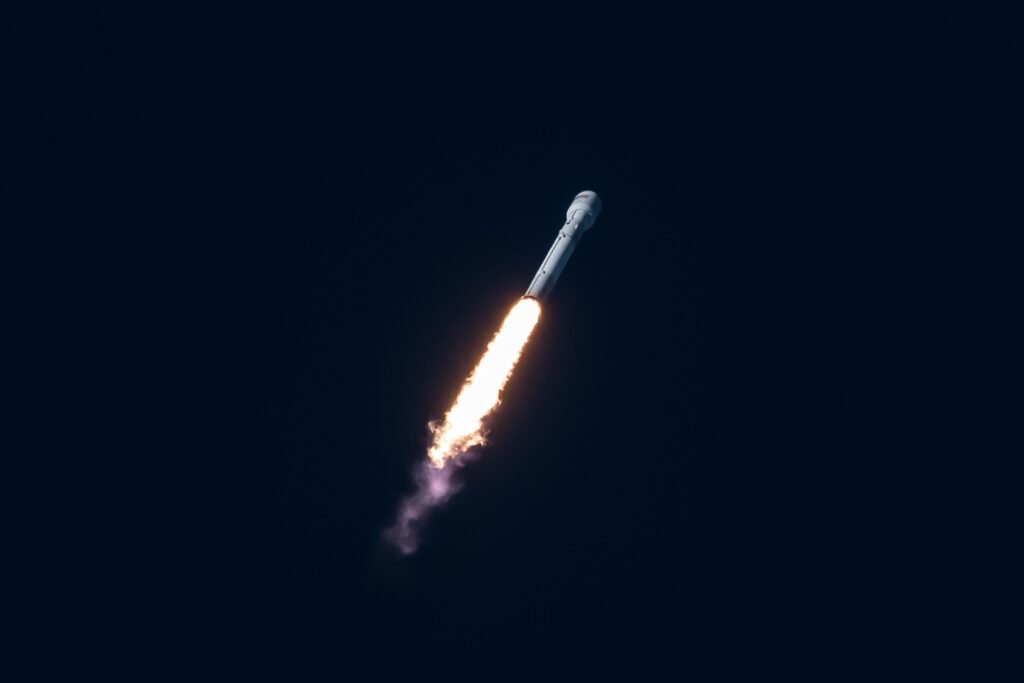Imagine a future where astronauts no longer have to rely solely on their own knowledge and instincts while exploring deep space. Instead, they have an advanced artificial intelligence (AI) system by their side, assisting them every step of the way. From analyzing complex data to making split-second decisions, AI is revolutionizing the way we explore the vastness of space. In this article, we will explore the significant role that AI plays in space exploration, shedding light on the incredible advancements and potential it holds for the future of humanity’s extraterrestrial adventures.

This image is property of images.unsplash.com.
Overview of AI in space exploration
Artificial Intelligence (AI) plays a crucial role in space exploration by enhancing the capabilities of autonomous systems, improving data analysis and interpretation, optimizing navigation and guidance systems, facilitating communication and collaboration, improving space telescopes and observations, advancing planetary science, mitigating risks, and ensuring mission success. With AI technology, space agencies and organizations can push the boundaries of space exploration, uncovering new knowledge and making groundbreaking discoveries.
Definition of AI
AI refers to the simulation of human intelligence in machines that are programmed to think and learn like humans. It entails the development of algorithms and models that enable machines to process data, make decisions, and achieve tasks without explicit human intervention. In the context of space exploration, AI enables spacecraft, rovers, and telescopes to operate autonomously, analyze vast amounts of data, enhance navigation systems, optimize resource allocation, facilitate communication, and collaborate with human astronauts.
History of AI in space exploration
The use of AI in space exploration has a rich history that dates back to the early days of space exploration. In the 1960s, AI-powered computers were used to process data from early space missions. The Mars Rover, launched by NASA in 1997, was one of the first significant examples of AI in space exploration. It utilized AI algorithms to navigate and analyze the Martian surface. Since then, AI has been continuously integrated into various space missions, advancing the capabilities of space technologies and expanding our understanding of the universe.
Key applications of AI in space exploration
AI finds extensive applications in space exploration, revolutionizing the way we explore and understand the cosmos. Some of the key applications of AI in space exploration include improving autonomous systems and robotics, data analysis and interpretation, enhancing navigation and guidance systems, optimizing resource allocation, facilitating communication and collaboration, improving space telescopes and observations, advancing planetary science, and mitigating risks.
Improving Autonomous Systems and Robotics
Automated control of spacecraft
One of the primary applications of AI in space exploration is automating spacecraft control. AI algorithms enable spacecraft to make autonomous decisions regarding trajectory adjustments, course corrections, and resource management. By reducing the reliance on ground-based control systems, AI allows for real-time decision-making and quicker response to changing conditions. This autonomy enhances mission efficiency and reduces the burden on human operators.
Robotic explorations on celestial bodies
AI plays a critical role in enabling robotic explorations on celestial bodies, such as planets, moons, and asteroids. By integrating AI algorithms into rovers and landers, these robotic systems can navigate challenging terrains, conduct scientific experiments, and collect samples. AI allows robots to adapt to unforeseen circumstances, assess risks, and make decisions based on real-time data. This capability is instrumental in expanding our knowledge of the cosmos and paving the way for human exploration.
Enhancing precision and safety in space missions
AI contributes to the enhancement of precision and safety in space missions through intelligent automation and predictive capabilities. AI algorithms assist in autonomous docking and rendezvous operations, ensuring precise positioning of spacecraft during complex maneuvers. Additionally, AI-based predictive analytics help identify anomalies and potential failures in space systems, allowing for proactive maintenance and reducing the risk of mission-critical failures. This combination of precision and safety ensures successful mission outcomes.
Data Analysis and Interpretation
Processing and understanding vast amounts of data
Space exploration generates an enormous amount of data, ranging from telemetry readings to images and spectral data. AI enables efficient processing and understanding of this vast amount of data, making it possible to extract valuable insights and make informed decisions. Machine learning algorithms can analyze patterns, classify data, and identify correlations that might not be apparent to human analysts. By rapidly processing and interpreting data, AI accelerates the pace of discovery and enhances our understanding of the universe.
Recognizing patterns and anomalies
AI algorithms excel in pattern recognition, enabling the detection of subtle patterns and anomalies in space data. By continuously analyzing and comparing data against established patterns, AI systems can identify deviations that might indicate hidden phenomena or irregularities. This capability is particularly useful in identifying new exoplanets, detecting gravitational waves, or spotting unusual atmospheric conditions. AI-driven pattern recognition enables scientists to uncover new insights and anomalies that can lead to groundbreaking discoveries.
Predictive analytics for mission planning
AI’s predictive analytics capabilities are instrumental in mission planning and decision-making. By analyzing historical mission data, AI models can predict the outcome of different scenarios and assess the feasibility of mission objectives. This data-driven approach helps optimize mission trajectories, resource allocation, and scientific objectives, reducing costs and improving the efficiency of space missions. With AI-supported predictive analytics, space agencies can make informed decisions and increase the chances of mission success.
Enhancing Navigation and Guidance Systems
Autonomous navigation and obstacle avoidance
AI enhances navigation and guidance systems by enabling autonomous spacecraft navigation and obstacle avoidance. AI algorithms process real-time sensor data to determine the spacecraft’s position, velocity, and orientation accurately. This information allows spacecraft to autonomously adjust their trajectories to avoid obstacles and maintain optimal paths, even in complex and dynamic environments. AI-driven autonomous navigation ensures safe and efficient maneuvering through space, reducing the potential for collisions and accidents.
Mapping and charting unknown territories
AI facilitates the mapping and charting of unknown territories in space. By combining high-resolution imaging data with AI algorithms, space missions can construct detailed maps of celestial bodies such as planets, moons, and asteroids. AI enables the identification and classification of surface features, geological formations, and potential landing sites. These maps and charts provide valuable information for future exploration missions and help identify areas of scientific interest for further investigation.
Accurate positioning and trajectory calculations
AI supports accurate positioning and trajectory calculations for spacecraft. By leveraging machine learning algorithms, AI systems can continuously refine their position estimation by comparing real-time sensor data with predefined models. This capability ensures precise control over spacecraft movements, enabling accurate trajectory calculations and course corrections. Accurate positioning and trajectory calculations are essential for successful interplanetary missions, enabling spacecraft to reach their destinations with maximum precision and efficiency.

This image is property of images.unsplash.com.
Optimizing Resource Allocation
Efficient utilization of propulsion systems
AI helps optimize the utilization of propulsion systems in space missions. By analyzing mission parameters, AI algorithms can determine the optimal thrust profiles, fuel consumption rates, and engine performance. This optimization reduces fuel consumption, maximizes mission duration, and enables more extensive exploration without significant resource constraints. AI-driven propulsion system optimization is particularly crucial for long-duration missions, enabling spacecraft to operate efficiently and achieve successful mission outcomes.
Maximizing power generation and consumption
AI plays a vital role in maximizing power generation and consumption in space missions. AI algorithms can monitor power generation systems, such as solar panels or nuclear reactors, and optimize their operation for maximum energy output. Additionally, AI models can manage power distribution and consumption across different spacecraft systems, ensuring optimal utilization and minimizing energy wastage. Efficient power management is essential for space missions, where energy resources are limited, and reliability is paramount.
Smart allocation of onboard resources
AI enables smart allocation of onboard resources in space missions. By analyzing various mission constraints and objectives, AI algorithms can optimize the allocation of resources such as food, water, and scientific instruments. This resource optimization ensures mission longevity and enables spacecraft to adapt to changing mission priorities or unforeseen events. AI-driven resource allocation ensures that spacecraft can operate effectively and efficiently throughout the duration of their missions, maximizing scientific output and mission success.
Facilitating Communication and Collaboration
AI-assisted human-robot interaction
AI facilitates communication and collaboration between human astronauts and robotic systems. By integrating natural language processing and machine learning algorithms, AI systems can understand and respond to human instructions, enabling seamless interaction between humans and robots. This capability is crucial for future space missions, where astronauts will rely heavily on robotic assistants for various tasks, including maintenance, scientific experiments, and exploration. AI-assisted human-robot interaction promotes efficient and effective collaboration, enhancing the capabilities of human-robot teams.
Interplanetary internet and network management
AI contributes to the development of interplanetary internet and network management systems. As space missions extend farther into the solar system, the need for reliable communication between spacecraft and Earth becomes essential. AI algorithms can manage network resources, routing, and data transmission protocols, ensuring efficient and reliable communication over vast distances. Interplanetary internet and network management systems powered by AI enable seamless data transfer, real-time command updates, and scientific data sharing, facilitating global collaboration and knowledge exchange.
Cross-mission knowledge sharing
AI facilitates cross-mission knowledge sharing and collaborative learning. By aggregating and analyzing data from multiple space missions, AI algorithms can identify common patterns, lessons learned, and best practices. This collective knowledge can then be shared across space agencies and organizations, enabling future missions to benefit from previous experiences and discoveries. Cross-mission knowledge sharing enhances the efficiency and effectiveness of space exploration and fosters a collaborative approach to advancing our understanding of the universe.

This image is property of images.unsplash.com.
Improving Space Telescopes and Observations
Automated image processing and data classification
AI improves the capabilities of space telescopes by enabling automated image processing and data classification. AI algorithms can analyze vast amounts of astronomical images and classify celestial objects with high accuracy. This automated image processing allows for the identification of potential targets for further study, such as exoplanets, supernovae, or distant galaxies. By automating these tasks, AI increases the efficiency of space telescopes, enabling faster and more precise observations.
Real-time identification of celestial objects
AI enables real-time identification of celestial objects, enhancing the capabilities of space telescopes and observation systems. By continuously analyzing incoming data streams, AI systems can identify and track celestial objects, including asteroids, comets, or transient events. Real-time identification allows for prompt follow-up observations and scientific investigations, ensuring that crucial astronomical events are not missed. AI-driven real-time identification enhances the timeliness and relevance of space observations, enabling scientists to study dynamic and rapidly evolving phenomena.
Event detection and anomaly alerts
AI algorithms contribute to event detection and anomaly alerts in space observations. By analyzing patterns and anomalies in astronomical data, AI systems can identify significant events, such as supernova explosions or gamma-ray bursts. These event detection capabilities enable scientists to respond quickly and allocate resources for targeted observations, maximizing scientific output. Additionally, AI-driven anomaly alerts can notify researchers of unexpected phenomena, promoting further investigation and fostering serendipitous discoveries.
Advancements in Planetary Science
Exoplanet discovery and characterization
AI revolutionizes the discovery and characterization of exoplanets, planets that orbit stars beyond our solar system. By analyzing vast amounts of observational data, AI algorithms can identify subtle signals indicative of exoplanet presence and determine their properties, such as size, composition, and orbital characteristics. AI-driven exoplanet discovery and characterization contribute to our understanding of planetary systems beyond our own, shedding light on the potential for habitable worlds and the distribution of life in the universe.
Planetary surface analysis and sample collection
AI enhances the analysis of planetary surfaces and the collection of samples during space missions. By utilizing machine learning algorithms, AI systems can analyze spectral data, images, and geological information to understand the composition and characteristics of planetary surfaces. This analysis facilitates targeted sample collection, enabling scientists to obtain valuable specimens for further analysis on Earth. AI-driven surface analysis and sample collection contribute to our knowledge of planetary geology and the processes that shape celestial bodies.
Analyzing atmospheric and geological data
AI algorithms excel in analyzing atmospheric and geological data from various celestial bodies. By processing sensor readings and satellite observations, AI systems can derive valuable insights into atmospheric compositions, weather patterns, and geological features. This analysis contributes to our understanding of the climates and geological processes on other planets and moons. AI-driven analysis of atmospheric and geological data enables planetary scientists to reconstruct the histories of celestial bodies and gain insights into the potential for habitability.
Mitigating Risks and Ensuring Mission Success
Predicting and managing space debris
AI aids in the prediction and management of space debris, which poses a significant risk to space missions. By analyzing orbital data and trajectories, AI algorithms can predict potential collisions with space debris and recommend corrective actions. AI-driven space debris management systems help spacecraft operators adjust trajectories, adopt evasive maneuvers, or plan debris removal missions. This proactive approach mitigates the risk of collisions, safeguarding valuable assets in space and ensuring the safety and success of missions.
Monitoring and reacting to solar flares
AI systems contribute to monitoring and reacting to solar flares, which emit intense bursts of radiation and pose risks to space missions and astronauts. By analyzing real-time data from solar observatories and space weather monitors, AI algorithms can detect and track solar flares, predicting their effects on spacecraft and human health. AI-driven solar flare monitoring systems enable mission planners to take necessary precautions, such as adjusting mission timelines or shielding sensitive equipment, reducing the impact of solar flares on space activities.
Emergency response and contingency planning
AI supports emergency response and contingency planning for space missions. By analyzing mission parameters and historical data, AI algorithms can develop predictive models for various emergency scenarios, such as system failures, natural disasters, or anomalies. These models enable mission planners to devise contingency plans, identifying alternative courses of action and response strategies. AI-driven emergency response and contingency planning enhance mission preparedness, ensuring a swift and effective response to unforeseen events and maintaining mission success.
Future Prospects and Challenges
Advances in AI and machine learning algorithms
The future of AI in space exploration holds the potential for significant advances in AI and machine learning algorithms. As technology continues to evolve, AI systems will become more sophisticated, capable of processing and analyzing vast amounts of data even faster. Advancements in machine learning algorithms, such as deep learning, reinforcement learning, and neural networks, will enhance the decision-making and pattern recognition capabilities of AI systems. These advances will enable more autonomous and intelligent space missions, pushing the boundaries of our understanding of the universe.
Ethical considerations and responsible use of AI
With the increasing integration of AI into space exploration, ethical considerations and responsible use of AI become essential. Space missions must navigate the ethical implications of autonomous systems and AI-driven decision-making. Safeguards need to be in place to ensure that AI systems operate within ethical boundaries, respecting human values and adhering to global principles. Responsible use of AI in space exploration involves transparency, accountability, and ongoing dialogue to ensure that AI technologies are utilized for the benefit of humanity and the preservation of the cosmos.
Collaboration between AI and human astronauts
The collaboration between AI and human astronauts will play a crucial role in future space missions. AI systems will support and augment the capabilities of human astronauts, providing assistance in tasks that are too dangerous or challenging for humans alone. The development of AI-human interfaces and interaction methods will be pivotal in enabling effective collaboration between humans and AI systems. Ensuring seamless communication, mutual understanding, and trust between humans and AI will be crucial for successful and harmonious space exploration endeavors.
In conclusion, AI has become an indispensable tool in space exploration, transforming the way we explore and understand the cosmos. Through its applications in improving autonomous systems and robotics, data analysis and interpretation, enhancing navigation and guidance systems, optimizing resource allocation, facilitating communication and collaboration, improving space telescopes and observations, advancing planetary science, and mitigating risks, AI contributes to the success and advancement of space missions. With continued advancements in AI technology and responsible utilization, the future of space exploration holds exciting possibilities for unraveling the mysteries of the universe and expanding our horizons beyond Earth.
